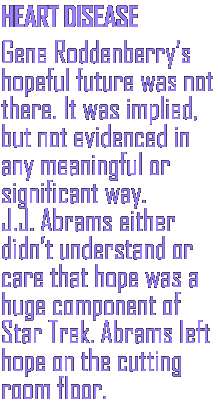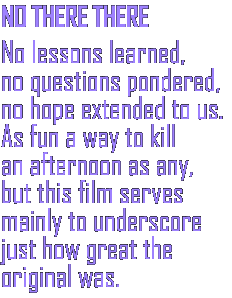
Whatever You Do, Don't Sell Any Copies.
Every time I go into Walmart, there they are: racks of 2009's Star Trek reboot DVD's, in both the no-frills and 2-disc special edition versions. Now approaching two years of age, Walmart continues to refuse to discount these DVD's off of their $19.99 and $24.99 list prices. I don't know if this is Walmart or Paramount's doing, but an employee told me on the QT that Walmart had bought dozens of pallets of the disc when it first shipped, assuming the film would fly off the shelves. The employee speculates Walmart paid too much for the discs and discounting them as they normally do DVD's after six and twelve and eighteen months would cause the store to lose money. So, there they sit. Two years later, still full price.
Films that came out around the same time and even after Trek are retailing for ten bucks, and previously viewed copies abound at about $7.99. The same strange phenomena happened with the stillborn Superman Returns, literally thousands of copies of which gathered dust in a huge, cardboard cube display (about five feet squared) for about two years. No store in town would lower the price for Returns from it's $19.99 list of the basic disc and an eye-gouging $29.99 for the deluxe set. This feels a lot like Apple Computer's price fixing: shop all you want, an iPad is $499 wherever you go. I'm not sure what the point is, for either Walmart or, even more puzzling, Paramount, to want to keep this film out of peoples' hands by demanding top rate for a two-year old movie, but most all things Trek have traditionally been grossly overpriced, $149 per season for most Trek box sets when you can catch House on sale for around $39.95. Maybe it's a contractual thing with director JJ Abrams. Maybe it's some uncanny marketing strategy that just sails over my head. In any case, I found a used copy for $4.99 and was just as thrilled.
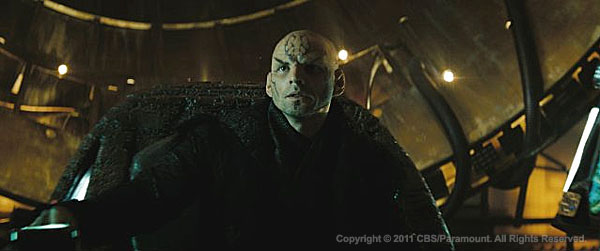
Didn't We Just See This Movie?: Eric Bana as the
terribly-named Nero (a popular CD-burning
software) echoes Tom Hardy's disastrous Shinzon from the
franchise-killing Star Trek: Nemesis.
The ships look identical, they look identical. What on earth was
Abrams thinking?
They got the Romulans wrong. Again.
The last Star Trek film, Nemesis, which killed the franchise,
made the Romulans stupid. Made them stupid Roman Centurions who
get hoodwinked by a piece of bad casting (click
here to read my
review). Tom Hardy portrayed Shinzon, a
supposed clone of The Next Generation’s Captain Jean-Luc Picard.
Regrettably Hardy, the actor playing Shinzon, couldn’t credibly
stand in the same room with Patrick Stewart, the wonderful
Shakespearean actor who played Picard for two decades, so the
whole “clone” notion never worked, not from frame one. Had they
cast Stewart to play his own clone, a much brighter idea, TNG
franchise might still be making flicks today. Astonishingly poor choices
were made all around, but I guess that's why the named them
dinosaurs. Make no mistake about it: Star Trek is a fun movie and
well worth seeing. But is it really Trek?
As with Nemesis, this new Star Trek places a rogue Romulan at
the center and then gets the Romulans completely wrong. The
entire point of Romulans are that they are liars. That they say
one thing then do another. Duplicity is their stock and trade.
It is, ultimately, what makes them interesting. TV Show Romulans
rarely, if ever, raised their voice. They spoke with an even,
calculated tone while never taking their eyes off you. They
polarized whatever room they might have been in. They were
thinkers moreso than warriors, and they used their intellect to
nefarious purposes.
Here, as in the awful Nemesis, the producers made the
Romulans simply stooges. Every Romulan in this film is a stooge
who screams and snarls and beats people up. Wrong. Romulans
don’t beat people up. They outsmart people, manipulating them
into beating themselves up. So, right away, I realize this is
yet another Star Trek film produced by people whose
understanding of Star Trek never makes it far below the Trek
epidermis: the bare basics of what the phenomena is about. And,
what’s the big deal? many will ask. The big deal is this: the
difference between a film and a franchise is how deep the rabbit
hole goes.
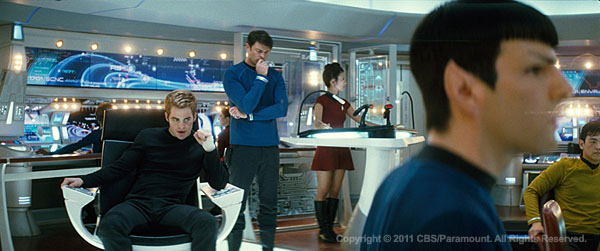
Designed By Steve Jobs:: The Enterprise bridge now looks like an Apple iPod or, say, a dentist's office.
The New Guy
Gene Roddenberry’s hopeful future was not there. It was implied,
perhaps taken for granted, but it was not evidenced in any
meaningful or significant way. That future—one in which poverty,
disease, war, hunger, and most human vices have been
eliminated—was what made Star Trek rise above most other
science-future spaceship serials. This is something director J.J.
Abrams either didn’t understand or didn’t care about: hope was a
huge component of Star Trek. Abrams left hope on the cutting
room floor.
The show also has heart disease. It’s a very clever film with
very interesting performances, but the film has no beating heart
at its center. Zachary Quinto, whose most compelling reason for
being there is his uncanny resemblance to Leonard Nimoy, comes
about as close to being, ironically, the picture's emotional
nexus as we get. Quinto's appropriately reserved inner turmoil
requires the audience to already know who Spock is and,
therefore, read into his performance a bit. Those less-informed
viewers might bounce off of Quinto's Spock as wooden and uneven,
but for those in the know, the new guy clearly runs away with the
picture, mowing down Chris Pine's unsatisfying Kirk at every
opportunity. Ironically, whiffs in the wind have it that all of
Trek's cast have re-signed for the sequel except Quinto,
mirroring original Spock Leonard Nimoy's repeated
foot-dragging/rope-a-dope which got old fairly quickly. Trek is
the biggest thing to happen to Quinto, who is likely and
understandably concerned about typecasting and therefore needs to
find some career ballast in other high-profile roles before he
can commit again to the ears. Additionally, Quinto likely knows
the entire picture rested on his shoulders and his spooky
resemblance to Nimoy. There was no one else in that picture who
enthralled us, no other arc worth following from Act One through
Act Three. That's real capital for Qunito, and smart management
will explore ways to use it.
Quinto
plays
Spock as if he’s never seen a Nimoy performance, which may have
been the point. Quinto's Spock
is so uninformed—lacking the charm and pristinely calculated wit
of the original—that every time he opened his mouth I was
disappointed. The Spock we’ve come to know over 30+ years
(unnervingly echoed by Tim Russ’ coolly disciplined Tuvok from
that awful Lost In Space Star Trek show) would never order Kirk
out of his chair (a funny line, but decidedly Not Spock). Thus,
Spock’s ongoing conflicts about his divided lineage simply ring
hollow: the young actor simply cannot bring Spock home for me,
and I’ve been waiting a very long time (thank goodness the real
thing appears in two extended cameos).
Worse, Chris Pine’s Kirk cannot hold the center of the film. He
simply lacks the gravity of William Shatner’s chronic
self-absorption, which informed Shatner’s performance as James
Tiberius Kirk. Bruce Greenwood, as Captain Christopher Pike,
simply mops the floor with Pine in every scene they share
together, upstaging the younger actor with Greenwood’s meaty
dimension as an actor and his character’s father figure to the
young Kirk. As ridiculous as it was, I actually bought Pike
promoting Kirk to first officer, largely on the strength of
Greenwood’s performance. It's not the absurdity of the plot
contrivance so much as how a seasoned actor sells it.
Greenwood's Pike saw greatness in Kirk. Had he a boat full of
veterans rather than 17-year olds like Chekov, he might have
made another choice. I would have groaned at the evasion of
logic, here, had any lesser actor spoken that line.
Kirk himself, however, is completely missing from the film.
Abrams seemingly capriciously banned Shatner (in both body and
spirit) from the production. It felt deliberate. It felt mean.
And it tinged my enjoyment of what is certainly a great movie.
The whole film felt hostile to Shatner. So much so that, instead
of simply enjoying the movie, I kept wondering what ax Paramount
or Abrams had to grind against the guy. The film's finale uses a
crane shot to discover Spock observing from a balcony. I assure
you every Trek fan who went to see this expected this to lead to
a reveal of Spock speaking with Kirk--Shatner Kirk. The cameo
would have lasted about thirty seconds, and it would have been a
powerful moment for the fans, for Shatner and for the franchise.
As is, the hand-off to the new kids feels like a convenience
store stick-up. I felt emotionally ripped off that this movie
would not handshake itself properly from the legacy that made it
possible.
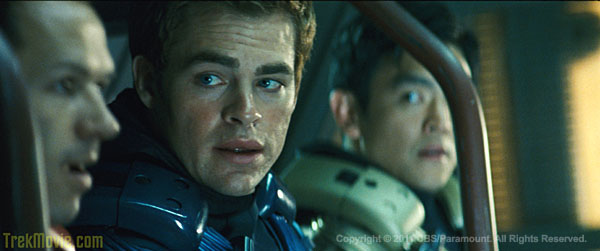
One Of These Things Is Not Like The Others:: Shatner who? In attempting to shed Trek of Shatner's ham, they also shed Trek of Trek. Rather than coming off as original, Pine cam across as if he can't act. Every time the camera pulled in on Pine, it was jarring, snapped me right out of the story. They should have either (a) toned down all that mirroring going on with the rest of the cast or (b) allowed Pine even a few brief moments to echo Shatner the way the remaining cast echoed their characters' previous incarnations.
He's Dead, Jim
The film's anti-Shatner bias is a strong undertow that distracts
from the narrative.
Pine plays Kirk as though he’s never heard of William Shatner. I
frankly do not know anyone alive over the age of 30 who can
not do a Captain Kirk/William Shatner imitation. Most every
other member of the cast (except Zoe Saldana, who plays a
terrific character called Uhura but who lacks the quiet strength
and discipline of Nichelle Nichols) seems to have used the
original characters as the foundation for their performances.
They certainly went their own way and made the characters their
own (perhaps most successfully, Simon Pegg’s very funny Scotty),
but Pine seems to have deliberately abandoned Shatner. Coupled
with the choice to not cast Shatner even in a cameo (the plot
re-shuffles the continuity deck so efficiently, no explanation
of Shatner’s walk-on would have been necessary), that I’m left
to conclude the producers wanted a Shatner-less Star Trek, which
is to miss the joy of Trek entirely.
As annoying and occasionally overblown as Shatner’s performances
can be, it is those very qualities which make Spock Spock and
McCoy McCoy. The new kid was simply too generic, a pale echo of
Tom Cruise’s Maverick from Top Gun (including an homage to
Maverick’s arrival at the air base on his motorcycle, Air Force jets
flying overhead. This is re-created, almost note
for note, here in Trek).
The casting, therefore, is out of balance. Pine’s groping,
generic Maverick Lite is no Kirk. Not even close. Not even a
hint, an echo, of that note in the symphony. So the triad of
Spock, Kirk, and McCoy simply does not work, here. Spock’s
arguments with McCoy seem strained and flat, missing the fire of
Deforest Kelley’s seeming disdain for Nimoy.
Worse, at no point does Kirk save the day. He performs heroic
acts but he is not a hero. At no point do I ever feel like he
was in any real peril, and the Kobayashi Maru “no win” scenario
never plays itself out in the plotline.
The film goes out of its way not to reimagine Kirk so much as to
banish Shatner, as if Shatner’s ghost might hold back a new
franchise. What might hold back a new franchise is the thinness
of the new premise, the performances being satire once removed,
and the lack of a Shatner at the center. Quinto’s Spock’s lack
of charm (not to mention his lack of Nimoy’s classic baritone)
doesn’t help. This film could easily have tipped over into the
realm of a Saturday Night Live sketch. As is, it teeters on the
brink.

What Were They Thinking?:: Trek undresses the only major
African American cast member,
Zoe Saldana's Uhura. They
should have (a) cast an additional major black cast member or
(b) kept her clothes on. The Anglo-centric Trek deeply insulted
the African American
community (and Uhura fans) with this
nonsense.
Here And Gone
There weren’t enough shots of the Enterprise, Abrams again missing a crucial point that the Enterprise herself is a major character in the franchise. We get, at best, fleeting occasional glimpses of the ship’s exterior with it's silly-looking Popeye-arm nacelles, and we’re left blinking and wondering what this version of the ship actually looks like. This is a mistake every film director has made with Trek since Robert Wise's lumbering and over-long tour of the Enterprise in space dock in Star Trek: The Motion Picture, a consequence of a rushed editing process as that show was being hurried to the airport, prints still wet in the cans lined up on the tarmac mere hours before the film's opening. Scoff at that lonnnnng leisurely tour of the ship all you want. Back in 1979, on a 40-foot widescreen, I distinctly recall gasps and then hushed silence as the packed movie house engaged in a kind of worship ceremony. There she was. The old gal completely reimagined and in such compelling detail we knew the model itself had to be huge. We wanted that long look. After ten years of waiting, that tour wasn't for Kirk, who could have pulled up the ship from dozens of angles on a huge widescreen monitor in his office. The tour was for us.
Every director since, perhaps wary of criticism over Wise's overlong tour (which seems overlong only on subsequent or repeated viewings; I'm telling you, first time you see this thing, in 40-feet of glorious Panavision, it's practically a theophany) has given us only fleeting glimpses of the ship. And they're all idiots. Including Nimoy, who gave us barely an eye blink of 1701-A just before rolling the credits on Star Trek IV. The notable exception was Nicholas Meyer in Trek's standard-bearer Wrath of Khan, whose budget was slashed from TMP's jaw-breaking numbers and therefore had to recycle Industrial Light and Magic's marvelous footage of the ship exterior. Meyer gave us an abbreviated lingering look at our beloved Enterprise, and did not rush us with subsequent exterior shots during the course of the film.
Ben Cross turns in a simply dreadful performance as Sarek,
Spock’s father. The part was played for decades by the
inimitable Mark Lenard, who passed away in 1996. Lenard’s Sarek
was Spock without the compassion. He was all discipline, and
Lenard’s performance had a through-point of self-loathing for
Sarek’s obvious compassion for his half-human son, and anger at
his son for causing Sarek to so obviously display that
compassion. Anger which, in wonderfully nuanced layers from a
brilliant actor, humiliated Sarek. Cross’s befuddled, doddering,
single-note performance fairly insults the richness of that
memory.
Finally, God was not in this movie. Not that He specifically
needed to be, but Star Trek not only had an innate sense of
hope, but was fairly evangelical in Kirk’s sense of faith. If
not faith in a specific Judeo Christian God, faith in the
bright future for mankind and, ultimately, the universe. Via his
trademark, halting speeches, Kirk routinely pondered the big
questions and gazed out at the stars. Whether deliberate or not,
he came across as a man of faith, and that hopeful optimism is
what made Trek Trek. Most all of that is missing from this new
Star Trek, which seems much less concerned about the hopeful
future, hitting the action beats squarely while forgetting to
give the film an actual soul.
There’s really not much here for young people except action and
a gratuitous scene of Uhura in her panties. It was an
unnecessary titillation that demeaned the actor’s otherwise
terrific performance and something Nichelle Nichols, the
original Uhura, would never have agreed to. The one major
female (and black) character in the film, and they made her take
her clothes off. The major reboot performances are only
interesting if you’re familiar with the originals, which these
performances vaguely echo without actually measuring up to. Eye
candy, lots of fun, but not enough depth to make the film
compelling. No lessons learned, no questions pondered, no hope
extended to us. They beat the bad guy, missing the point that,
for most of its existence and for most of its incarnations, Star
Trek had no bad guy. Conflict was created out of larger issues,
with even perceived bad guys Klingon, Borg, etc. acting as
agents of conflict while being consistent to their internal
logic.
There were precious few mustache-twirling villains in Trek, including the greatest villain of all, Ricardo Montalban's hammy, scenery-chewing Khan, whose gregarious histrionics went toe-to-toe with Shatner's own. In 30 years of trying, Khan's villainy has simply been unmatched. The sad legacy of the trek franchise is their repeated attempts to cath lightning in a bottle. With perhaps the lowest budget of any of the franchise's films and an untested young director (Meyer), cast and crew created the landmark and definitive Star Trek film, one Paramount has spent hundreds of millions unsuccessfully trying to recreate. Eric Bana's Nero's obsession with Spock, blaming Spock for something Spock failed to do--a real stretch to sell to the audience--was intended, I suppose, to mirror Khan's obsession with Kirk, but echoed instead the disastrous Shinzon from the franchise-killer Nemesis. Even the ship looked the same. What on earth (or in space) was Abrams thinking? Khan was all passion, a kind of mirror to Kirk. Nero had absolutely no resonance with either New or Classic Spock. As fun a way to kill an afternoon as any, and I suppose the film will rake in lots of cash. But, for this Trek fan, it serves manly to underscore just how great the original was.
Christopher J. Priest
11 May 2009
Home | Blog | Projects | Comics | Rants | Music | Video | Christian Site | Contact
Star Trek Copyright © 2011 CBS/Paramount. All Rights Reserved.
Text Copyright © 2011 Lamercie Park. All Rights Reserved.
TOP OF PAGE


